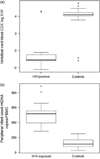Effects of in utero antiretroviral exposure on mitochondrial DNA levels, mitochondrial function and oxidative stress
- PMID: 22103263
- PMCID: PMC3913063
- DOI: 10.1111/j.1468-1293.2011.00945.x
Effects of in utero antiretroviral exposure on mitochondrial DNA levels, mitochondrial function and oxidative stress
Abstract
Objectives: HIV and antiretroviral (ART) exposure in utero may have deleterious effects on the infant, but uncertainty still exists. The objective of this study was to evaluate aspects of mitochondrial DNA (mtDNA) content, mitochondrial function and oxidative stress simultaneously in placenta, umbilical cord blood and infant blood in HIV/ART-exposed infants compared with uninfected controls.
Methods: HIV-1-infected pregnant women and HIV-1-uninfected healthy pregnant controls were enrolled in the study prospectively. Placenta and umbilical cord blood were obtained at delivery and infant blood was obtained within 48 h of delivery. mtDNA content was determined for each specimen. Nuclear [subunit IV of cytochrome c-oxidase (COX IV)]- and mitochondrial (COX II)-encoded polypeptides of the oxidative phosphorylation enzyme cytochrome c-oxidase were quantified in cord and infant blood. Placental mitochondria malondialdehyde (MDA) concentrations were measured as a marker of oxidative stress.
Results: Twenty HIV-positive/HIV-exposed and 26 control mother-infant pairs were enrolled in the study. All HIV-infected women and their infants received ART. Placental MDA concentration and mtDNA content in placenta and cord blood were similar between groups. The cord blood COX II:IV ratio was lower in the HIV-positive group than in the controls, whereas the infant peripheral blood mtDNA content was higher in the HIV-exposed infants, but the infant peripheral blood COX II:IV ratio was similar. No infant had clinical evidence of mitochondrial disease or acquired HIV infection. In multivariable regression analyses, the significant findings in cord and infant blood were both most associated with HIV/ART exposure.
Conclusions: HIV-exposed infants showed reduced umbilical cord blood mitochondrial enzyme expression with increased infant peripheral blood mitochondrial DNA levels, the latter possibly reflecting a compensatory mechanism to overcome HIV/ART-associated mitochondrial toxicity.
© 2011 British HIV Association.
Conflict of interest statement
Figures

Similar articles
-
Perinatal outcomes, mitochondrial toxicity and apoptosis in HIV-treated pregnant women and in-utero-exposed newborn.AIDS. 2012 Feb 20;26(4):419-28. doi: 10.1097/QAD.0b013e32834f3232. AIDS. 2012. PMID: 22156962
-
Placental Mitochondrial Toxicity, Oxidative Stress, Apoptosis, and Adverse Perinatal Outcomes in HIV Pregnancies Under Antiretroviral Treatment Containing Zidovudine.J Acquir Immune Defic Syndr. 2017 Aug 1;75(4):e113-e119. doi: 10.1097/QAI.0000000000001334. J Acquir Immune Defic Syndr. 2017. PMID: 28234688
-
Mitochondrial toxicity in HIV type-1-exposed pregnancies in the era of highly active antiretroviral therapy.Antivir Ther. 2009;14(3):331-8. Antivir Ther. 2009. PMID: 19474467
-
HIV and mitochondrial toxicity in children.J Antimicrob Chemother. 2008 Jan;61(1):8-12. doi: 10.1093/jac/dkm411. Epub 2007 Nov 13. J Antimicrob Chemother. 2008. PMID: 17999978 Review.
-
Pharmacokinetics, Placental and Breast Milk Transfer of Antiretroviral Drugs in Pregnant and Lactating Women Living with HIV.Curr Pharm Des. 2019;25(5):556-576. doi: 10.2174/1381612825666190320162507. Curr Pharm Des. 2019. PMID: 30894103 Review.
Cited by
-
Metabolic complications of in utero maternal HIV and antiretroviral exposure in HIV-exposed infants.Pediatr Infect Dis J. 2014 Jul;33(7):734-40. doi: 10.1097/INF.0000000000000224. Pediatr Infect Dis J. 2014. PMID: 24378947 Free PMC article.
-
Elevated Blood Mitochondrial DNA in Early Life Among Uninfected Children Exposed to Human Immunodeficiency Virus and Combination Antiretroviral Therapy in utero.J Infect Dis. 2021 Feb 24;223(4):621-631. doi: 10.1093/infdis/jiaa410. J Infect Dis. 2021. PMID: 32638023 Free PMC article.
-
Remdesivir increases mtDNA copy number causing mild alterations to oxidative phosphorylation.Sci Rep. 2023 Sep 15;13(1):15339. doi: 10.1038/s41598-023-42704-y. Sci Rep. 2023. PMID: 37714940 Free PMC article.
-
Maternal HIV Infection and Antiretroviral Therapy in Pregnancy: Implications for Vertical Transmission, Fetal Safety, and Long-Term Infant Outcomes.Pathogens. 2025 Aug 19;14(8):818. doi: 10.3390/pathogens14080818. Pathogens. 2025. PMID: 40872328 Free PMC article. Review.
-
Immune and Metabolic Alterations in Children with Perinatal HIV Exposure.Viruses. 2023 Jan 18;15(2):279. doi: 10.3390/v15020279. Viruses. 2023. PMID: 36851493 Free PMC article. Review.
References
-
- Cooper ER, Charurat M, Mofenson L, et al. Combination antiretroviral strategies for the treatment of pregnant HIV-1-infected women and prevention of perinatal HIV-1 transmission. J Acquir Immune Defic Syndr. 2002;29:484–494. - PubMed
-
- Gerschenson M, Erhart SW, Paik CY, et al. Fetal mitochondrial heart and skeletal muscle damage in Erythrocebus patas monkeys exposed in utero to 3′-azido-3′-deoxythymidine. AIDS Res Hum Retroviruses. 2000;16:635–644. - PubMed
-
- Ewings EL, Gerschenson M, St Claire MC, et al. Genotoxic and functional consequences of transplacental zidovudine exposure in fetal monkey brain mitochondria. J Acquir Immune Defic Syndr. 2000;24:100–105. - PubMed
-
- Blanche S, Tardieu M, Rustin P, et al. Persistent mitochondrial dysfunction and perinatal exposure to antiretroviral nucleoside analogues. Lancet. 1999;354:1084–1089. - PubMed
-
- Barret B, Tardieu M, Rustin P, et al. Persistent mitochondrial dysfunction in HIV-1-exposed but uninfected infants: clinical screening in a large prospective cohort. AIDS. 2003;17:1769–1785. - PubMed
Publication types
MeSH terms
Substances
Grants and funding
LinkOut - more resources
Full Text Sources
Medical

